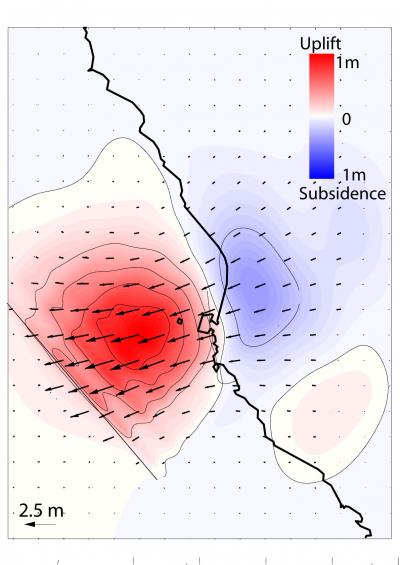A magnitude 8.0. earthquake destroyed 90 percent of the city of Pisco, Peru on August 16, 2007. The event killed 595 people, while another 318 were missing. Tsunami waves were observed locally, off the shore of Chile, and as far away as New Zealand.
In a study published in the Geophysical Journal International, scientists from the University of Miami's Rosenstiel School of Marine and Atmospheric Science, in collaboration with scientists from the University of Oxford (U.K.) have analyzed data on this earthquake and its impact on regional topography. Using InSAR-based geodetic data and teleseismic data, the scientists were able to use satellite images to identify details of this major plate boundary event.

Three-dimensional deformation following the 2007 Pisco, Peru
earthquake. The red areas show ~1m of uplift offshore and the blues
areas about 50 cm of subsidence on land. The hinge-line between
uplift and subsidence closely matches the location of the coastline.
Credit: UM Rosenstiel School
"Unfortunately, historical earthquakes in Central Peru show a complex repeat pattern making it difficult to identify which area will be affected in the future," said Rosenstiel School Postdoctoral Fellow and Principal Investigator Dr. Juliet Biggs. "The convergence of the Nazca and the South American plates is slowly building the Andes, but the relationship between great earthquakes and mountain building processes is still unclear."
Intriguingly, models developed as a result of this event in 2007 demonstrated no upper lifting of the region after this major earthquake. Long-term uplift of the upper plate must either occur aseismically or as 'slow earthquakes' during the interseismic or postseismic part of the earthquake cycle.
Support for the project came from the U.S. National Science Foundation. The earthquake confirmed a common feature for earthquakes in central Peru: maximum intensity and damage occur few tens of kilometers south of the epicenter. This is a key observation for disaster management and tsunami prediction.
"Visiting Peru immediately after the earthquake together with fellow researcher Kim Outerbridge provided us with a desolating picture of the affected region, but it was critically important for data-gathering," Biggs said.
The collaboration with Dr. Edmundo Norabuena, a former graduate from the Rosenstiel School now at Instituto Geofísico del Perú, to deploy GPS equipment in the region permitted collection of essential data, which will be the subject of a new study. This will provide details on the movement generated deep inside the earth after the earthquake, which is another crucial part of the puzzle in terms of our understanding of the recurrence intervals of major earthquakes.


